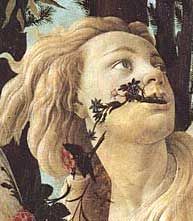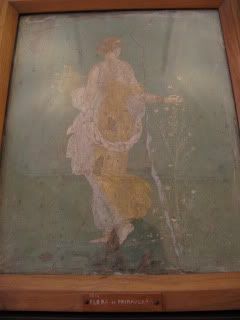As seen in previous blog, Chloris/Flora was the Goddess of flowers and certainly a symbol of Spring.
DEMETER-CERERE(CERES)
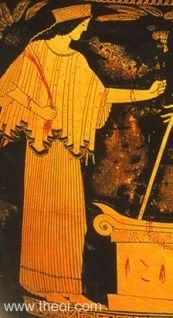
Demeter

Cerere/Ceres
Spring is not just about flowers however, it also means renewal, fertility, agriculture, … EARTH! So in addition to Flora there was another great spring Goddess,her name was Demeter. Demeter was the Goddess of Corn (grain), patroness of agriculture and the good harvest, bestower of fertility,the Mother Earth. The Roman equivalent of Demeter was Cerere (Ceres), the word means wheat or grain in Latin (our word cereal comes from the name Cerere). Demeter/Ceres represent the prime sustenance of mankind.
Demeter was the daughter of Cronus and Rhea. Her daughter was Persephone, Proserpina in the Roman version of the Myth. Demeter’s festival was celebrated at harvest time, usually in September. Her temple was at Eleusis, a town near Athens, and the worship of Demeter was called the Eleusinian Mysteries.
After the corn plants were harvested, the luxuriant green fields died, and the frost set in, the earth was barren and sad. Man needed an explanation for the changes of the seasons and stories were told to explain the reasons for the changes. The story that explained the changes is told in one of the earliest Homeric Hymns.
Homeric Hymn to Demeter
Translated by Gregory Nag
“I begin to sing of Demeter, the holy goddess with the beautiful hair.
And her daughter [Persephone] too. The one with the delicate ankles, whom Hadês seized.
She was given away by Zeus, the loud-thunderer, the one who sees far and wide.
Demeter did not take part in this, she of the golden double-axe, she who glories in the harvest.
She [Persephone] was having a good time, along with the daughters of Okeanos, who wear their girdles slung low.
She was picking flowers: roses, crocus, and beautiful violets.
Up and down the soft meadow. Iris blossoms too she picked, and hyacinth.
And the narcissus, which was grown as a lure for the flower-faced girl by Gai [Earth].
All according to the plans of Zeus."
etc.
According to the Hymn Demeter had a daughter named Persephone, the maiden of spring. One day Persephone was gathering flowers when enticed by the beautiful bloom of the Narcissus, she separated herself from her friends and went to gather the flower. The god of the underworld used the Narcissus in order to abduct the beautiful maiden, bring her to Hades and make her his bride.

Persepohone by Kris Waldherr
Persephone was now lost to her mother and in her terrible grief Demeter withheld her gifts from the earth, the green and flowering land became icebound and lifeless. Nothing grew, no seed sprang up, it seemed that mankind would die from famine.
Zeus finally stepped in and sent Hermes to the underworld to bid the ‘groom’ to let his bride go back to Demeter. The god of the underworld had to obey Zeus and send Persephone back up to the world and her mother. However he first enticed his bride to eat the seeds of the Pomegranate, knowing that if she did so she must return to him. Hermes returned Persephone to her mother who upon learning of the eaten Pomegranate seeds grieved knowing that she would lose her daughter again. Fortunately wise Zeus sent another messenger to Demeter, Rhea, and an agreement was reached. Demeter will have her daughter to comfort her mother:
“As each year is accomplished and bitter winter is ended.
For a third part only the kingdom of darkness shall hold her.
For the rest you will keep her, you and the happy immortals.
Peace now. Give men life which comes alone from your giving.”
Demeter agreed and once more made the fields rich with abundant fruit and the whole world bright with flowers and green leaves.

The Return of Persephone by F. Leighton
In the book “On Persephone’s Island” by Mary Taylor Simeti , the author says that Enna in Sicily is the ancient seat of the cult of Demeter/Ceres. Together with her daughter Persephone/Proserpina, she held all of Sicily, the most fertile of the Mediterranean islands, in her protection, and her shrine stood on the top of the mountain Enna, overlooking the wheat fields and the flowering plain where Hades (Dis) galloped his black horses as he bore off Persephone, known to the Romans as Proserpina, to be his queen in the Underworld.
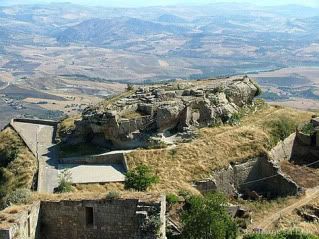
La Rocca di Cerere, These are the archeological remains of the sanctuary of Demeter, built by the Greeks in ENNA
“Near Enna's walls a spacious lake is spread,
Fam'd for the sweetly-singing swans it bred;
Pergusa is its name: and never more
Were heard, or sweeter on Cayster's shore.
Woods crown the lake; and Phoebus ne'er invades
The tufted fences, or offends the shades:
Fresh fragrant breezes fan the verdant bow'rs,
And the moist ground smiles with enamel'd flow'rs
The chearful birds their airy carols sing,
And the whole year is one eternal spring.
Here, while young Proserpine, among the maids,
Diverts herself in these delicious shades;
While like a child with busy speed and care
She gathers lillies here, and vi'lets there;
While first to fill her little lap she strives,
Hell's grizly monarch at the shade arrives;
Sees her thus sporting on the flow'ry green,
And loves the blooming maid, as soon as seen.
His urgent flame impatient of delay,
Swift as his thought he seiz'd the beauteous prey,
And bore her in his sooty carr away.
The frighted Goddess to her mother cries,
But all in vain, for now far off she flies;
Far she behind her leaves her virgin train;
To them too cries, and cries to them in vain,
And, while with passion she repeats her call,
The vi'lets from her lap, and lillies fall:
She misses 'em, poor heart! and makes new moan;
Her lillies, ah! are lost, her vi'lets gone.
OVID, THE METAMORHOSES
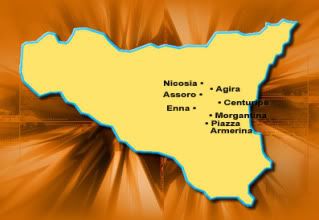
Enna is located at the very center of Sicily

Pinax of Persephone and Hades on the throne. Found in the holy shrine of Persephone at Locri in the district Mannella. Locri was part of Magna Graecia and is situated on the coast of the Ionian Sea in Calabria, Italy.



